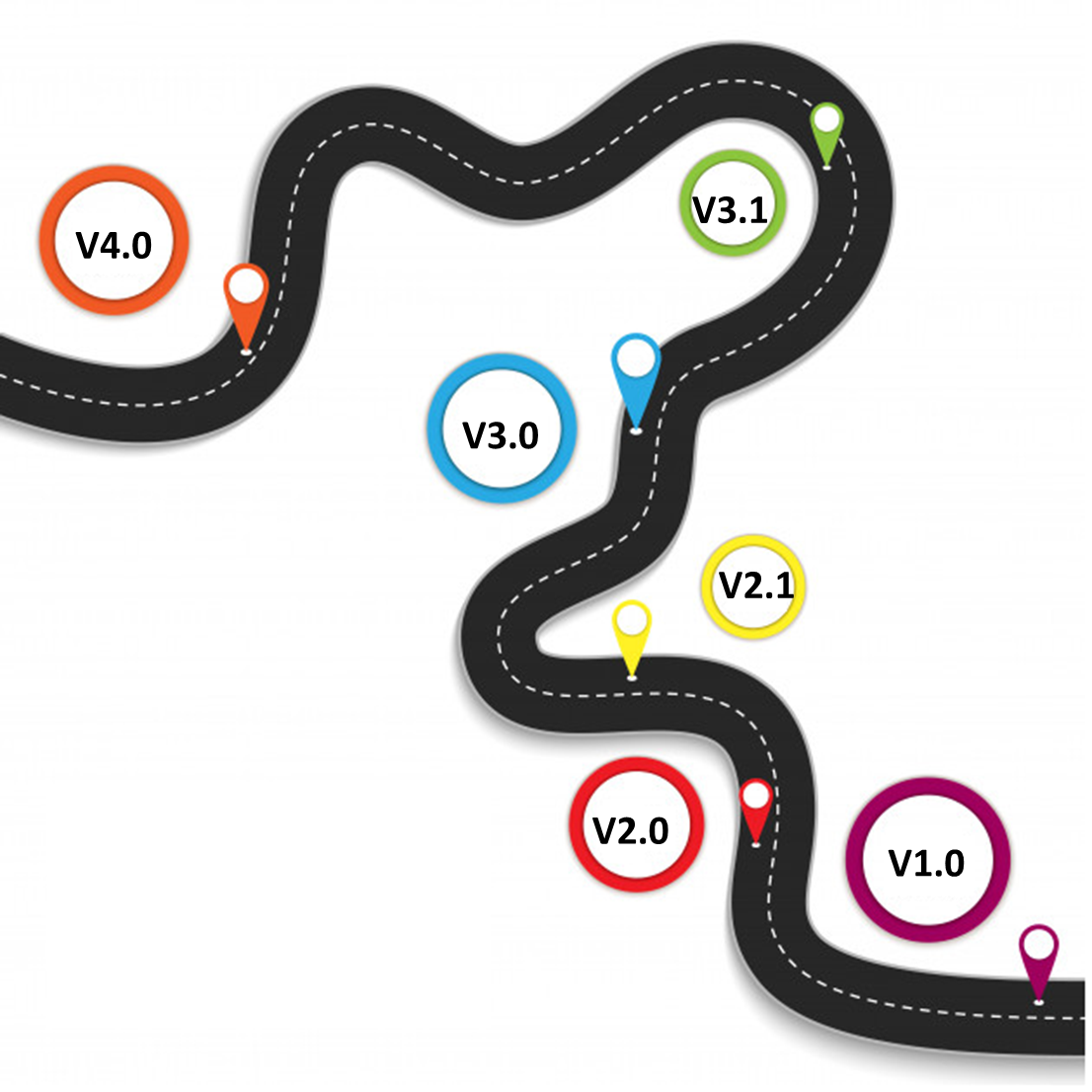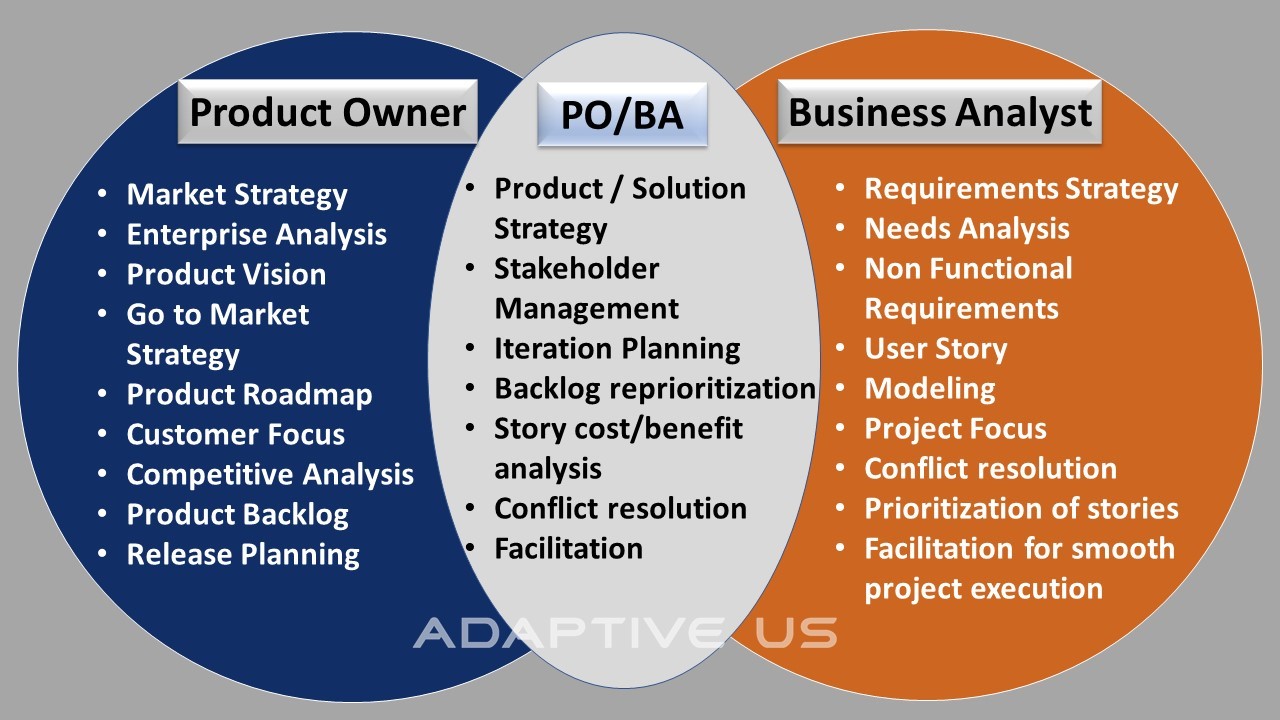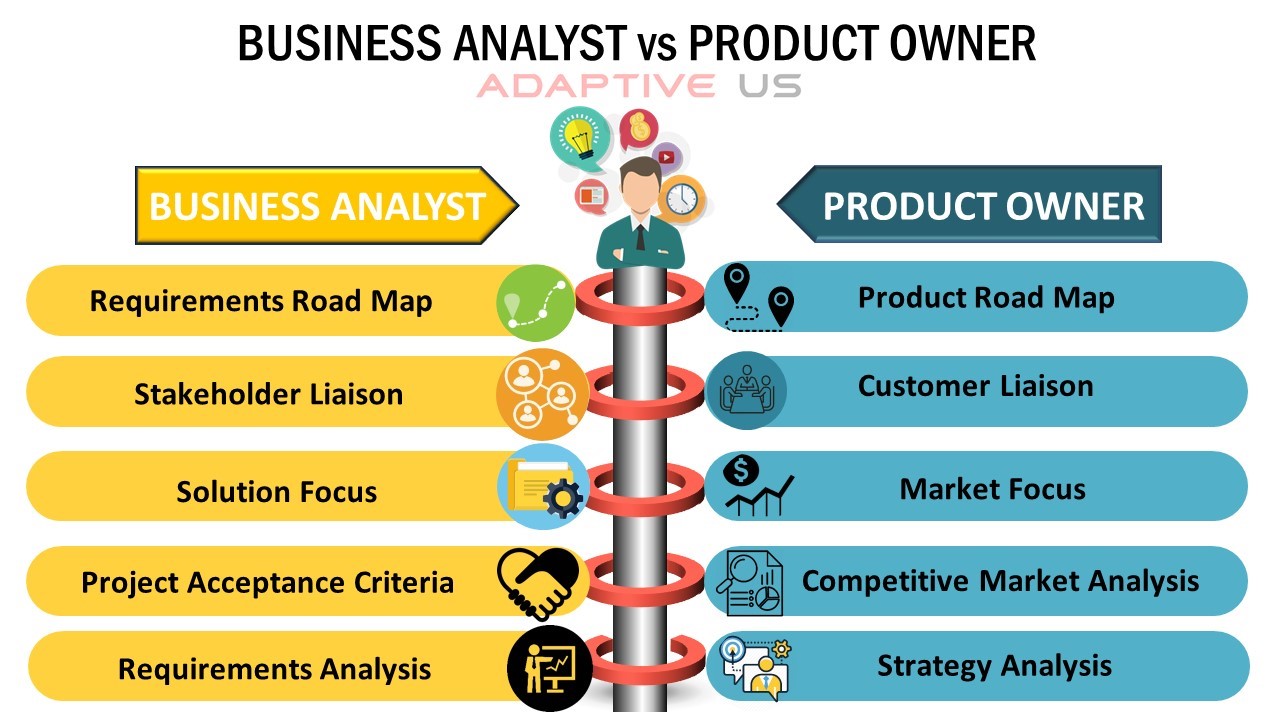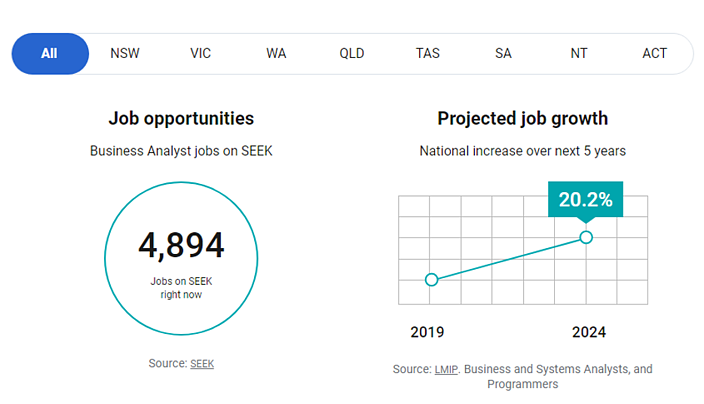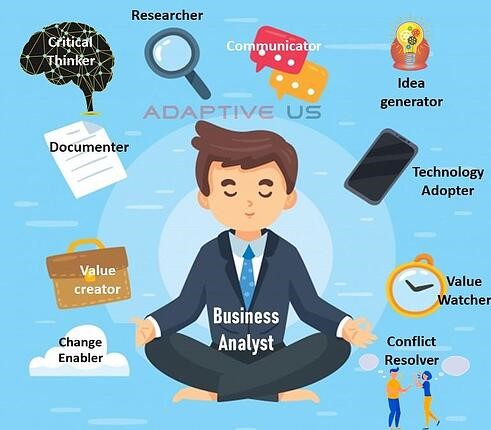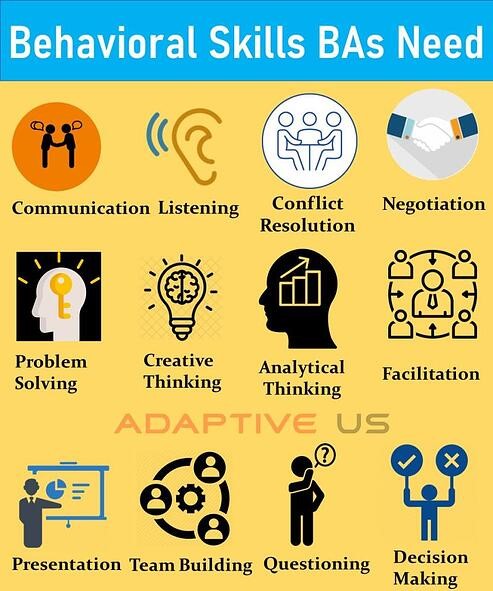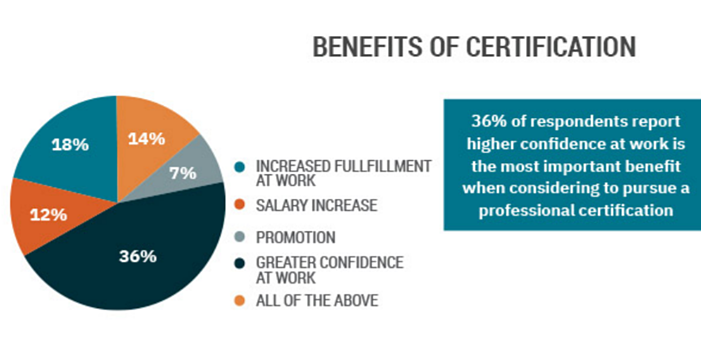Business analysis has been identified as a key discipline in organizations across the globe. Business analysts enable the enterprise to articulate its needs, the rationale for change, and design and describe solutions that deliver value. Business analysis can be performed in a project or across the enterprise. It is used to understand the current state, define the future state and determine activities required for the transition.
This skill has been in great demand and seeing a significant growth pattern for the last few years and has been identified as the hot skill to acquire by LinkedIn Learning and the US Bureau of Labor statistics.
The BA profession is one of the fastest-growing occupations. Between 2014-2014* a 14% industry growth has been projected. BA career prospects growing are very promising.
*Source: US Bureau of Labor Statistics
However, many times we business analysts get caught up in our daily job. They perform only one part of this dynamic role over the years, keeping ourselves away from the practices/techniques beyond our organizational boundary. It is critical to get a holistic view of the profession and be skilled in the tools and techniques practiced across the industry to climb the career ladder and reach greater heights.
Industry certifications such as IIBA are proven ways to get oneself established in the industry and achieve much-aspired growth in the profession in terms of skill, visibility, personal branding, career growth, to name a few. In fact, it opens a myriad of opportunities for a business analysis professional.
This article is meant for those wishing to achieve IIBA certification on the first attempt without falling for the deadly failure traps.
The article will discuss:
- Strategy to ace the IIBA certification exam
- Choosing the certification to pursue
- How to come up with a perfect study plan for yourself
- Preparing with the best resources
- Choosing the right Mentor
- Putting up your application without breaking your head
- Preparing yourself with the right tools of exam simulators
- Learning the best tips to handle exam anxiety
- Getting the infrastructure set up to ensure a seamless exam experience
- The most common failure traps that many exam takers have stumbled on
- Memorizing BABoK instead of understanding the flow and the terminologies
- Relying too much on one’s experience as a BA
- Lack of proper understanding of BABoK terminologies and expectation
- Not preparing with the right resources, right model questions, and simulators for practice
- Expecting direct questions from BABoK
- Poor time management
- Exam anxiety / Getting stressed
- Underestimating the exam complexity
- Inadequate preparation
- Getting stressed based on the initial difficulty level of questions
Strategy to ace the IIBA certification exam
- Choosing the certification to pursue
If you are looking at making your foundation strong in the Business Analysis role and want to be a distinguished BA, you should get formally trained, skilled, and certified in IIBA certifications.
IIBA Certifications are the most desirable BA certifications for business analysts to excel in their careers.
IIBA has three core business analysis certifications: ECBA, CCBA, and CBAP, and 4 specialized certifications, AAC, CBDA, CCA, and CPOA.
The core certifications have been around for a while. They have gained popularity as they focus on business analysis skills and techniques. They also have some eligibility criteria set by IIBA for professionals to qualify to take up the exam.
Here is a basic guide to help evaluate which certification should you be pursuing:
- Beginners/newbies, college grads, and anyone looking to start a BA career or transition to a BA career should pursue ECBA.
- Professionals with 2.5+ years of BA work experience in the last 7 years of work history should pursue CCBA.
- Professionals with 5+ years of BA work experience in the last 10 years should pursue CBAP.
Many times, one may not be a designated BA but may be performing the responsibilities of a BA; some of those roles are (but are not limited to)
- ERP Implementation
- Product implementation
- Process mapping and improvement
- Change management consultant
- Functional consultant
The biggest myth around IIBA certifications is one must complete the lower-level certifications before moving to the higher one.
You can go to any level without going through the previous ones as well.
How to come up with a perfect study plan for yourself
- Plan 1 hour of study per day or 6 -8 hours of study per week
- Plan your study based on the kind of a learner you are, e.g., auditory, visual, kinesthetic, or reading writing
- An expert/instructor-led class may be the best to start with, followed by studying the concepts from the BABoK/KAs. The expert provides a simpler way of interpreting BABoK and underlying concepts, making it easy to understand and follow.
- Do self-study of the knowledge areas, one by one, followed by quizzes or questions based on each knowledge area, to test your understanding.
- Take practice exam question
- Timeline
- Training Sessions: 1 week (Fast track) /4 – 8 weeks (staggered class)
- BABoK study guide: 2 – 3 weeks
- BABoK reading: 2- 3 weeks
- Flashcard, Video & Audio learning (optional): 2-3 weeks
- Quizzes
- Chapter-wise tests: 4 weeks
- Revising the areas where you faltered: 1- 2 weeks
- Revise study guide and key concepts: 1-2 weeks
- Simulation exam: 2- 3 weeks
- Preparing with the best resources
Though BABoK is the ultimate guide that one needs to prepare for the IIBA core certifications, the book’s sheer size makes it very intimidating. A foolproof plan for preparation should include additional study material to help absorb the main concepts of the BABoK.
A good step is to get hold of a good BABoK Study Guide from an IIBA endorsed training provider, along with other curated content like question banks, exam simulators, exam tips & prep plans, video & audio learning, etc.
Crisp and curated study content will reduce your study time and help you prepare in a more structured manner.
Additive’s best-selling free eBook, 200 IIBA® Exam Prep Questions, is an amazing resource to accelerate your journey towards becoming a highly paid and sought-after IIBA certified business analyst. Utilized by 1000s of BA professionals globally, this book has everything you MUST know to ace your IIBA Exams along with 200 IIBA sample questions!
- Choosing the right Mentor
A crucial part of the IIBA certification exam preparation is that you should choose the right Mentor. A mentor is usually an IIBA certified trainer/coach who is an expert in the business analysis domain. Make sure that your trainer has not only gone through the rigorous IIBA exams and aced it but also knows what it takes to crack them.
Having someone qualified to guide you through the certification exam preparation can make the entire process less daunting. The help that your Mentor can provide in decoding BABoK is priceless not only for your IIBA exams but also to become a high performing BA and stand out in your BA job.
- Putting up your application without breaking your head
The application for the IIBA certification exams can be filed through the IIBA website. The Handbook- core-ba-certification-handbook.pdf (IIBA®.org), gives the detailed steps on filling the application form.
Adaptive US offers an Application Simulator as a part of its Certification Prep Training, that takes care of all the requirements from IIBA for the certification exams.
- Preparing yourself with the right tools – Exam Simulators
A good set of simulation questions prepares you for the various kind of questions that you will face in the actual exam.
Go through the explanations given for the answers during the test. They will help you in assessing your strengths and weaknesses. Study the areas that you have faltered in once more.
Remember, these simulation practice tests give you the most accurate feedback on your exam readiness. They let you know how well you have understood the BABoK and able to apply it in a given case or a scenario. This gives you extremely valuable knowledge to apply in your BA job as well, where you need to put your concepts/techniques to use.
You can consider yourself ready for the exam once you consistently score over 80% in each knowledge area of your simulation exams.
- Learning the best tips to handle exam anxiety
For BA professionals who have most probably not written any exam for quite some time, maybe decades, the thought of writing an exam can be pretty stressful. While it is quite normal to be a little nervous about giving an exam, you should not allow exam anxiety to be debilitating.
Some tips for handling your exam anxieties:
- Eat healthily and exercise regularly
- Get plenty of sleep
- Learn relaxation techniques
- Have a positive mental attitude
- Keep to a regular and structured study routine
- Do not feel anxious about the ‘Inadequate Preparation’ feeling
- Take an adequate number of practice exams. Once you score well on these exams, the anxiety level should reduce.
- Getting the infrastructure set up to ensure a seamless exam experience
The IIBA exams are now available online. This is an excellent step from IIBA as it allows BAs around the globe to appear for the exams and allow them the ease of giving the exam from the comfort of their homes.
The exams are now live and remotely proctored, requiring a desktop or laptop, a good internet connection, a working webcam, and a microphone.
The infrastructure requirements that you need to ensure-
- Your identity proof copy
- Make sure that you have the hardware required for the exam.
- The online proctored exam is dependent on the Internet connectivity, firewalls, VPN, and camera quality. Make sure that these are of good quality and functional.
- Perform the compatibility test on the scheduling website- https://home.psiexams.com/#/home. This will ensure that there are no kinks during your exam time.
The blog Ground Rules for IIBA Online Examinations gives you a detailed view of all the infrastructure requirements and the rules for the IIBA certification exam.
The most common failure traps that many exam takers have stumbled on
- Memorizing BABoK instead of understanding the flow and the terminologies
IIBA exams like CBAP and CCBA are competency-based. To answer the IIBA exam questions, you need to understand the concepts in BABoK and their application, rather than memorizing the book. You need to understand the tasks, techniques well, and their relationship with each other. Though it is useful to commit some of the concepts in BABoK to memory, you cannot answer the questions by rote.
- Relying too much on one’s experience as a BA
The answers to the IIBA certification exam questions are based on the concepts, tasks, techniques and definitions of BABoK rather than your individual experience as a BA. Instead of using your work experience to answer the questions, you need to apply the concepts from BABoK to the real world and then answer the questions. The inability to correlate the knowledge of BABoK can be detrimental to your exam performance.
- Lack of proper understanding of BABoK terminologies and expectation
IIBA exams like ECBA are knowledge-based, and thus, you need to know the terminologies to answer the questions correctly. In the higher-level exams, there may be terms from BABoK that are not generally used in your organization. It is essential to know the terms used in BABoK and relate them to the terms used in your organization. Therefore, you need to familiarize yourself with the terms used in BABoK to pass the exam.
A good BABoK Glossary explaining the various terms is a very helpful and valuable resource.
- Not preparing with the right resources, right model questions, and simulators for practice
If the learning material, practice questions, and simulators you are using are not adequate or based on BABoK, it will be challenging to clear the exam.
Attending an IIBA Certification training course will help not only with the resources required to prepare for the certification exam but will also help you identify the study methods that work best for you.
You can attend the live Interactive Exam Tips Webinar with Adaptive experts and ensure your chances of passing the exams on your first attempt
- Expecting direct questions from BABoK
Another reason why many people fail to clear the exam is that they expect direct questions from BABoK. Exams like CCBA and CBAP have no direct questions. The questions are lengthy and complex.
Time management is the key skill to cracking the IIBA certification exams. There have been cases where people have struggled to complete the exam. Several of our past students have told us that they could finish the exam just in time.
Some questions, like case-based or mathematical questions, require more time than the others, so it is essential to keep track of the time you spend on each question.
You should formulate a clear time management strategy that will help you optimize your time during the exam.
- Exam anxiety / Getting stressed
Exam anxiety has the power to wreck weeks and months of hard work and preparation. There are several strategies, as discussed earlier in this blog, that can help reduce exam anxiety. Practice those steps diligently to be stress-free on your exam day.Exam anxiety / Getting stressed
- Underestimating the exam complexity
Sometimes professionals with ample BA experience feel that their experience will help them sail through the IIBA exam like a cakewalk.
Underestimating the exam, its difficulty, and becoming complacent are some of the main reasons for failure in the IIBA exams. You need to remember that though BA experience is important and it helps, that is not the only thing required to become successful in the exam. To achieve your certification goal, you need to dedicate time to read through and prepare from BABoK and apply the concepts learned to answer the questions.
Some of the reasons why the exam preparation is not adequate are-
- Going for the exam too soon- If you are unsure of your preparation level, wait until you are comfortable with BABoK and then submit your application.
- Inadequate preparation time- IIBA exam needs a dedicated amount of study time. If you do not devote adequate time to study, it is more likely than not that you will be unsuccessful in passing the exam.
- Not being guided by the right Mentor/ Coach
- Not attending a proper IIBA certification training under an EEP (highly recommended by IIBA)- Statistics have proven that people who attend a prep course tend to have a higher chance of achieving their goal.
- Inadequate question preparation- It is well known that practice makes a person perfect. Thus, it is imperative to practice as many sample exam questions as possible. Simulation tests help you understand the level of complexity of the questions you will face during the exam.
Getting stressed based on the initial difficulty level of questions
Many exams follow the approach where intentionally, the initial questions are tougher. This is done to test the candidate’s mental strength, confidence level, and ability to handle complex tasks.
Keep your cool, and don’t get flustered, as the stress will negatively affect your performance.
This will help you chalk out your certification path that will lead to success in completing your IIBA certification goal. The above strategies and common mistakes will definitely the points you want to make sure to follow and ace your IIBA exam on the first attempt.
DON’T FORGET TO DOWNLOAD YOUR FREE COPY OF EBOOK OF 200 IIBA EXAM QUESTIONS TODAY!














